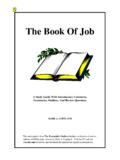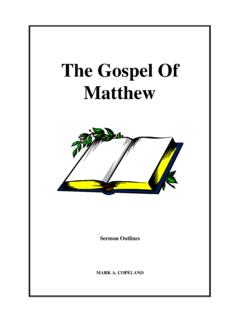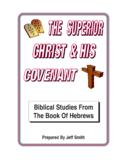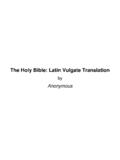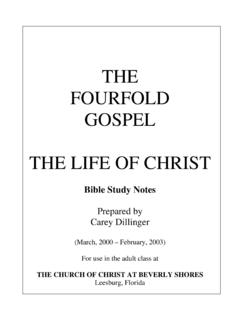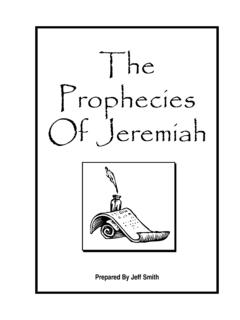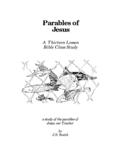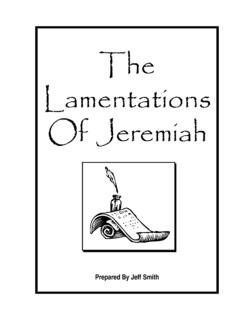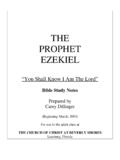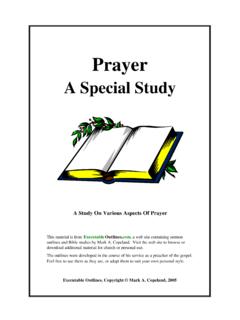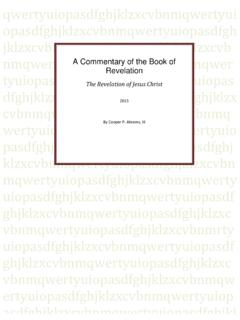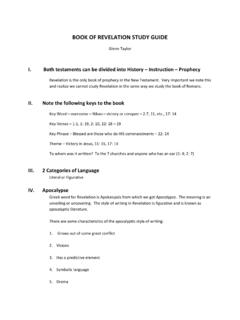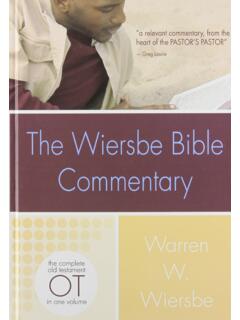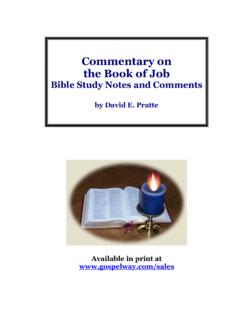Transcription of The Book Of Revelation - Bible Study Guide
1 The book OfRevelationA Study Guide With Introductory Comments,Summaries, Outlines, And Review QuestionsMARK A. COPELANDThe book Of RevelationTable Of ContentsIntroduction3 Chapter Twelve59 Chapter One12 Chapter Thirteen63 Chapter Two17 Chapter Fourteen67 Chapter Three22 Chapter Fifteen72 Chapter Four27 Chapter Sixteen75 Chapter Five31 Chapter Seventeen79 Chapter Six35 Chapter Eighteen84 Chapter Seven39 Chapter Nineteen89 Chapter Eight43 Chapter Twenty94 Chapter Nine47 Chapter Twenty-One98 Chapter Ten51 Chapter Twenty-Two 103 Chapter Eleven54 This Study Guide was developed in preparation for teaching adult Bible objectives for each section are usually things I plan to emphasize during have found that summarizing and outlining helps me to better understand the Wordof God.
2 It is a practice I highly recommend to generally delete the answers to the review questions before printing the materialand giving it to the students. But that you might know what answers were intendedby the questions, I have included them in these outlines were developed in the course of my ministry as a preacher of the gospel. They areincluded in The Executable Outlines Series, a collection my sermon outlines and Bible studymaterials. Visit the EO web site ( ) to browse or download more material. Feel free to use them as they are, or adapt them to suit your own personal style. To God be the glory!The Executable Outlines Series, Copyright Mark A. Copeland, A. CopelandThe book Of Revelation 2 The book Of RevelationIntroductionAUTHORJohn, identified as one "who bore witness to the word of God, and to the testimony of Jesus Christ"(1:1-2).
3 While debated by some, he was most likely the apostle John, brother of James, and authorof the gospel of John and three epistles. His authorship of this book is supported by the testimony ofJustin Martyr (165 ), Clement of Alexandria (220 ), Hippolytus (236 ), and Origen ( ).THE UNIQUE NATURE OF THE BOOKR evelation is certainly different from other books of the New Testament. It is also very different fromany kind of writing that is familiar to most people today. Unfortunately, this has caused some people toshy away from the book ; or on the other hand, to misuse it in propagating wild and fanciful people conclude it is just too mysterious to understand. But it was actually written to make thingsclearer! The word " Revelation " in the Greek is apokalupsis, which means "an uncovering" or"unveiling.
4 " It is therefore a book designed to uncover or unveil, not of the challenge in understanding the book is that it is written in a style not familiar to modern is an example of what is called "apocalyptic literature" which was quite popular from 200 to200 As such, it was a type of literature well known to the Jews and Christians of the first centurychurch. Features of apocalyptic literature include the use of highly symbolic or figurative language (cf."signified", 1:1). It was normally written in times of persecution, usually depicting the conflict betweengood and are other examples of apocalyptic literature in the Bible . In the Old Testament, for example, thebooks of Ezekiel, Daniel, and Zechariah each contain elements of this style of writing.
5 In the NewTestament, Matthew 24 contains apocalyptic DIFFICULTY IN UNDERSTANDING THE BOOKThe early church likely did not have the problem understanding the book we do today. They were wellacquainted with the style of apocalyptic literature. They were living at a time when the symbols of thebook were likely familiar to them (similar to how a picture of a donkey fighting an elephant would beunderstood by us as depicting conflict between the Democratic and Republican parties). In fact, Ibelieve the book was originally intended to be understood by a casual hearing, as implied by the opening beatitude:"Blessed is he who reads and those who hear the words of this prophecy, andkeep those things which are written in it; for the time is near." (1:3)Mark A. CopelandThe book Of Revelation 3 This verse suggests a setting in which one is reading while others listen.
6 The listeners were expected tounderstand enough to be blessed by what they difficulty with this book is due to our unfamiliarity with apocalyptic literature as a method ofcommunicating a message. We are also far removed from the historical and cultural context of the timeswhich would make the symbolism easier to understand. To properly interpret the book , we must try tounderstand the historical context in which it was written. We must also interpret it in a manner thatwould have been meaningful to those to whom it was first VIEWS OF INTERPRETATIOND ifferent views of interpreting the book generally fall into four categories:The "preterist" view - The book refers to events that were fulfilled in the first century , or shortlythereafter. It was written primarily to encourage the original readers.
7 Its value for today wouldtherefore be didactic (teaching the value of faithfulness to God).The "historicist" view - The book provides a panoramic view of the future of the church from as itgoes through history. This view finds in the book such events as the rise of Catholicism, Islam, the Protestant reformation, world wars, etc., ending with the return of Christ. As such it would encourageChristians no matter when they "futurist" view - Apart from the first few chapters, the book depicts events which immediatelyprecede the second coming of Christ. Therefore most of the book has yet to be fulfilled (or is beingfulfilled now), and its value is primarily for Christians who will be living at the time Jesus "idealist" view - The book does not deal with any specific historical situation.
8 Instead, it issimply enforcing the principle that good will ultimately triumph over evil. As such the book is applicableto any METHOD OF INTERPRETATIONI believe a proper interpretation of the book incorporates some of all these views. In my estimation, the "preterist" view has the most merit for the following reasons:wThe book was written specifically to seven churches in Asia (modern Turkey) - 1:4wIts purpose was to uncover or reveal "things which must shortly come to pass" -1:1, 3; 22:6,10wJohn was told, "Do not seal the words of the prophecy of this book , for the time isat hand" - 22:10 Compare the last two points with Daniel 8:26, where Daniel was told to "seal up" his vision, "for itrefers to many days in the future". Yet we know that his vision was fulfilled within several hundredMark A.
9 CopelandThe book Of Revelation 4years. John, however, was told "do not seal" what he had seen, "for the time is at hand". Howcould this be, if the bulk of Revelation refers to what has yet to occur almost two thousands later? Thisis a problem I see with the "futurist" view, which places primary fulfillment of the book thousands ofyears since its yourself in the position of those Christians in the churches of Asia in the first century. They weretold that the things described in the Revelation would "shortly come to pass", which should comfortthem. But according to the "futurist" view, it has been nearly 2000 years and much of the book has yetto be fulfilled! That would be like someone today writing that something is soon coming to pass, whenin reality it will be 4000 before it does!
10 How would a book depicting events to occur thousandsof years in the future comfort those who were suffering in the first century is not to say there are no "futurist" elements in the book . I understand chapters 20-22 to deal withthe ultimate destiny of the redeemed, which would have been of great interest and comfort to theChristians suffering in the first approach to the book , therefore, will be primarily from the "preterist" viewpoint, with occasionalelements from other DATE OF THE BOOKD ating when the book was written is not without controversy. When one dates the book will certainlyhave a bearing upon one's interpretation of the book , especially if one follows the "preterist" view. Twodates are usually proposed:wAn "early date", around 64-68 , during the reign of the Roman emperor, NerowA "late date", around 95-96 , during the reign of emperor DomitianThe "external evidence" (evidence outside the book itself) is inconclusive.
